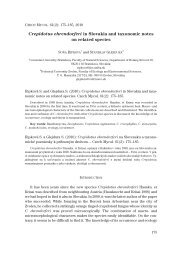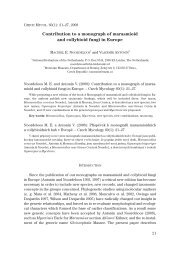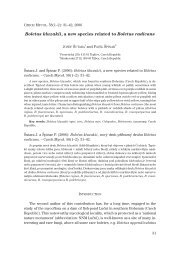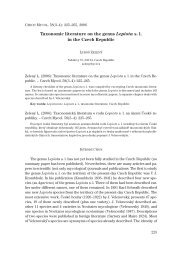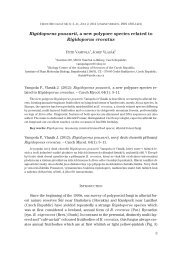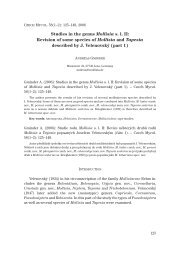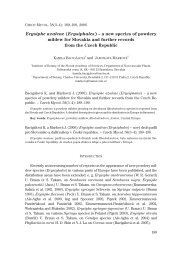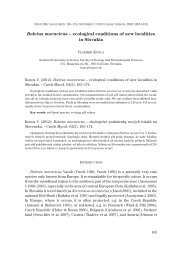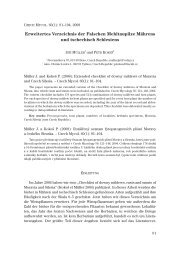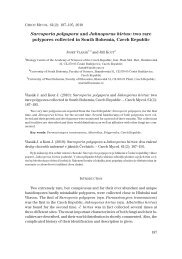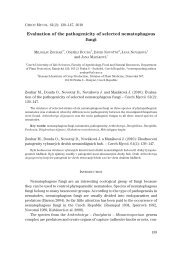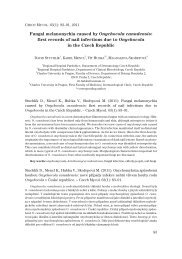Variability of internal transcribed spacer ribosomal DNA sequences ...
Variability of internal transcribed spacer ribosomal DNA sequences ...
Variability of internal transcribed spacer ribosomal DNA sequences ...
Create successful ePaper yourself
Turn your PDF publications into a flip-book with our unique Google optimized e-Paper software.
CZECH MYCOLOGY 64(1): 55–64, JULY 2, 2012 (ONLINE VERSION, ISSN 1805-1421)<br />
<strong>Variability</strong> <strong>of</strong> <strong>internal</strong> <strong>transcribed</strong> <strong>spacer</strong> <strong>ribosomal</strong> <strong>DNA</strong><br />
<strong>sequences</strong> <strong>of</strong> Fuscoporia gilva and Fuscoporia sp. in Thailand<br />
YUWADEE INSUMRAN 1 , USA KLINHOM 2 , PAIROT PRAMUAL 3*<br />
1,2,3 Mahasarakham University, Faculty <strong>of</strong> Science, Department <strong>of</strong> Biology, Kantharawichai District,<br />
Maha Sarakham, 44150, Thailand<br />
1 insumran_y@yahoo.com, 2 klinhomusa@gmail.com, 3 pairot.p@msu.ac.th<br />
*corresponding author<br />
Insumran Y., Klinhom U., Pramual P. (2012): <strong>Variability</strong> <strong>of</strong> <strong>internal</strong> <strong>transcribed</strong><br />
<strong>spacer</strong> <strong>ribosomal</strong> <strong>DNA</strong> <strong>sequences</strong> <strong>of</strong> Fuscoporia gilva and Fuscoporia sp. in Thailand.<br />
– Czech Mycol. 64(1): 55–64.<br />
The objectives <strong>of</strong> this study were to examine genetic variation based on the ITS region <strong>of</strong> the <strong>ribosomal</strong><br />
RNA gene <strong>sequences</strong> <strong>of</strong> Fuscoporia sp. and F. gilva from Thailand. Considerable levels <strong>of</strong> genetic<br />
variation were found in the Thai samples. The mean intraspecific genetic divergence was 5.74 % for<br />
Fuscoporia sp. and 5.33 % for F. gilva, indicating that they might be composed <strong>of</strong> several genetically distinct<br />
species. Phylogenetic analyses revealed that Fuscoporia sp. from Thailand was genetically related<br />
to F. callimorpha and F. senex. However, comparisons <strong>of</strong> the morphological characters and the level <strong>of</strong><br />
genetic divergence indicated that they were different taxa. Two divergence lineages among Thai<br />
Fuscoporia sp. associated with host species preference were found. This finding could indicate the role<br />
<strong>of</strong> host association in genetic divergence and probably speciation. Fuscoporia gilva from Thailand was<br />
clustered with conspecific species from other geographic regions. Nonetheless, levels <strong>of</strong> genetic differentiation<br />
are highly consistent with their divergent phylogenetic clades. This indicates that specimens from<br />
Thailand might represent genetically distinct species. Further study using other genes and an in-depth<br />
morphological analysis would be needed to clarify the species status <strong>of</strong> these important mushrooms.<br />
Key words: Fuscoporia, Internal Transcribed Spacer, medicinal mushroom, Hymenochaetales.<br />
Insumran Y., Klinhom U., Pramual P. (2012): Variabilita ITS obasti ribozomální<br />
<strong>DNA</strong> u Fuscoporia gilva a Fuscoporia sp. z Thajska. – Czech Mycol. 64(1): 55–64.<br />
Cílem této studie bylo prozkoumání genetické variability založené na <strong>DNA</strong> sekvencích ITS oblasti ribozomálního<br />
RNA genu u druhů Fuscoporia sp. a F. gilva z Thajska. Mezi thajskými sběry byla zjištěna<br />
vysoká míra genetické variability. Průměrná vnitrodruhová genetická divergence byla 5,74 % u Fuscoporia<br />
sp. a 5.33 % u F. gilva, což poukazuje na možnost, že se jedná o skupiny zahrnující více druhů. Fylogenetické<br />
analýzy odhalily, že druh Fuscoporia sp. z Thajska je geneticky příbuzný druhům F. callimorpha<br />
a F. senex; nicméně míra genetické divergence a studium morfologických znaků dokazují, že se jedná<br />
o odlišné taxony. V rámci Fuscoporia sp. byly odhaleny dvě genetické linie lišící se vazbou na hostitelské<br />
dřeviny. Toto zjištění poukazuje na roli hostitelské vazby při genetické divergenci a pravděpodobně i speciaci.<br />
Fuscoporia gilva z Thajska tvoří jednu skupinu se sekvencemi stejného druhu z jiných zeměpisných<br />
oblastí, příčemž vysoký stupeň genetické diferenciace odpovídá pozicím těchto sekvencí v odlišných<br />
fylogenetických kladech. Tyto výsledky naznačují, že sběry z Thajska mohou patřit k odlišným druhům.<br />
Podrobnější výzkum založený na fylogenetické analýze většího počtu genů a důkladných morfologických<br />
studiích by byl potřebný k ujasnění statusu těchto významných hub.<br />
55
CZECH MYCOLOGY 64(1): 55–64, JULY 2, 2012 (ONLINE VERSION, ISSN 1805-1421)<br />
INTRODUCTION<br />
Many species <strong>of</strong> the Hymenochaetaceae are used as medicinal fungi (Dai et al.<br />
2010). Among these, species belonging to Phellinus s.l. have received special attention.<br />
Several effects from the extracts <strong>of</strong> Phellinus mushrooms have been reported,<br />
including inhibition <strong>of</strong> pulmonary inflammation (Jang et al. 2004), promotion<br />
<strong>of</strong> dermal wound healing (Bae et al. 2005), immunostimulation (Kim et al.<br />
1996), anti-tumour activity (Han et al. 1999), anti-oxidant and anti-hepatotoxicity<br />
activity (Ajith & Janardhanan 2002), and anti-microbial activity (Dulger et al.<br />
2005). Other applications, such as decolorisation <strong>of</strong> textile indigo dye (Balan &<br />
Monteiro 2001), have also been reported. Phellinus species are important plant<br />
pathogens as well (Chang 1995, Dai et al. 2007).<br />
Phellinus s.l. is the largest genus <strong>of</strong> the Hymenochaetaceae including about<br />
220 species (Dai 2010). Some species previously placed in the genus Phellinus,<br />
such as Phellinus gilvus and P. torulosus, were transferred to Fuscoporia (Wagner<br />
& Fischer 2001, 2002). This has been supported by more recent molecular<br />
data, since phylogenetic analysis revealed close relations between P. torulosus<br />
and P. gilvus, and the members <strong>of</strong> Fuscoporia (Jeong et al. 2005). Recently 13 species<br />
<strong>of</strong> Fuscoporia have been reported from East Asia (Dai 2010, Ghobad-Nejhad<br />
& Dai 2007). However, due to the paucity <strong>of</strong> information on species distributions<br />
in tropical Asia, data on the geographic distribution <strong>of</strong> each species is not yet<br />
available for that area.<br />
Because <strong>of</strong> their medicinal and ecological importance, correct species identification<br />
is crucial for further study. <strong>DNA</strong> <strong>sequences</strong> are increasingly helpful in species<br />
identification (Hebert et al. 2003). The barcoding region <strong>of</strong> fungi has not yet<br />
been formally accepted, but the ITS region is among the most commonly used<br />
(Seifert 2009). ITS <strong>sequences</strong> have been successfully used to delineate species <strong>of</strong><br />
several fungal species (e.g. Smith & Sivasithamparam 2000, Jageat et al. 2010).<br />
However, there is great variation in the intraspecific genetic divergence within the<br />
kingdom; thus there is still a problem with using ITS for species identification in<br />
the fungi (Nilsson et al. 2008). Despite this limitation, molecular data is useful for<br />
revealing cryptic diversity. Recent molecular studies found that one morphological<br />
species could be composed <strong>of</strong> several genetically distinct species (Smith &<br />
Sivasithamparam 2000, Jargeat et al. 2010), which indicated the importance <strong>of</strong><br />
molecular markers for fungal taxonomy (Seifert 2009).<br />
The objectives <strong>of</strong> this study were to examine ITS sequence variation in two<br />
taxa, Fuscoporia gilva (Schwein) T. Wagner & M. Fisch. and Fuscoporia sp. from<br />
Thailand and to assess levels <strong>of</strong> genetic differentiation with related fungi from<br />
other geographic regions. Our results will be useful to reveal the species status <strong>of</strong><br />
these fungi.<br />
56
INSUMRAN Y., KLINHOM U.,PRAMUAL P.: VARIABILITY OF <strong>DNA</strong> OF FUSCOPORIA GILVA AND FUSCOPORIA SP.<br />
MATERIALS AND METHODS<br />
Sample collection and species identification. Samples<strong>of</strong>Fuscoporia<br />
sp. and F. gilva were collected in natural habitats in Thailand (Tab. 1). The key<br />
to Fuscoporia species by Dai (2010) was used for species identification. All specimens<br />
used in this study were deposited in the herbarium <strong>of</strong> the Natural Medicinal<br />
Mushroom Museum (MSUT), Faculty <strong>of</strong> Science, Mahasarakham University, Thailand.<br />
C u l t u r e , D N A i s o l a t i o n a n d P C R a m p l i f i c a t i o n . Mycelium was<br />
cultured following a method described by Dr. Jae-Mo Sung (Kangwon National<br />
University, Korea, pers. comm.). Small pieces <strong>of</strong> basidiocarps were cut aseptically<br />
using a razor blade and sterilised by placing them in 10% Clorox for 10 minutes,<br />
then rinsed in sterilised distilled water three times and dried on sterile filter paper.<br />
A piece <strong>of</strong> basidiocarp was placed into a Petri dish and the spores were allowed to<br />
discharge into Malt Extract Agar (2 % malt extract, 2 % agar, 0.05 % yeast extract in<br />
distilled water) overnight. The plates were incubated at 25° C for 7–15 days.<br />
Genomic <strong>DNA</strong> was extracted from the mycelium using the Plant Genomic<br />
<strong>DNA</strong> Extraction Kit (RBC Bioscience Corp., Taiwan). Mycelium was ground into<br />
a powder in liquid nitrogen and <strong>DNA</strong> was extracted following the manufacturer’s<br />
protocol. <strong>DNA</strong> samples were stored at –20 °C. A fragment <strong>of</strong> the ITS region was<br />
amplified using the primers ITS1 and ITS4 (White et al. 1990). The PCR reaction<br />
was performed in a total volume <strong>of</strong> 50 μl <strong>of</strong> liquid containing 1x reaction buffer,<br />
1.5 mM MgCl 2<br />
, 0.2 mM <strong>of</strong> each dNTP, 2.5 μM <strong>of</strong> each primer, 0.4 units <strong>of</strong> Taq <strong>DNA</strong><br />
polymerase, and 2 μl <strong>of</strong> <strong>DNA</strong> sample (diluted 1:20 in ddH 2<br />
O). The temperature pr<strong>of</strong>ile<br />
was 94 °C for 2 min. followed by 36 cycles <strong>of</strong> denaturing at 94 °C for 45 s, annealing<br />
at 50 °C for 45 s, extension at 72 °C for 1.30 min. and a final extension at<br />
72 °C for 5 min. PCR products were checked on a 1% agarose gel with 0.125 mg/l<br />
ethidium bromide. PCR products were cleaned using the PCR purification kit<br />
(RBC Bioscience, Taiwan) and were sequenced using the same primers as in the<br />
PCR by the <strong>DNA</strong> Sequencing Service <strong>of</strong> Macrogen (Seoul, Korea).<br />
D a t a a n a l y s i s . Sequences were aligned using the Clustal W algorithm in<br />
BioEdit (Hall 1999) with final manual editing. Genetic variation within and between<br />
species was calculated based on the Kimura 2-parameter using MEGA 4.1<br />
(Tamura et al. 2007). Maximum parsimony (MP) analysis was conducted in PAUP<br />
4.10b (Sw<strong>of</strong>ford 2002) using the default setting. Bootstrap supports were calculated<br />
based on 1,000 pseudoreplications. Neighbour-joining (NJ) trees were analysed<br />
using the Kimura 2-parameter model by PAUP with the heuristic general<br />
search option. Bootstrap support was calculated with permutations <strong>of</strong> 1,000<br />
pseudoreplications. Phylogeny based on the Bayesian method was analysed with<br />
MrBayes version 3.1.2 (Huelsenbeck & Ronquist 2001). The general time-reversible<br />
model <strong>of</strong> substitution with gamma distribution was selected.<br />
57
CZECH MYCOLOGY 64(1): 55–64, JULY 2, 2012 (ONLINE VERSION, ISSN 1805-1421)<br />
Tab. 1. List <strong>of</strong> fungi analysed in this study.<br />
ATCC – American Type Culture Collection, CBS – Centraalbureau voor Schimmelcultures, KCTC – Korean Collection for Type Cultures, MPUN – Microbiology<br />
Laboratory <strong>of</strong> Pusan National University.<br />
Species Host Locations/Source Voucher<br />
number<br />
GenBank accession<br />
number<br />
Reference<br />
Fuscoporia sp. Peltophorum dasyrachis Si Saket Province, Thailand MSUT451 JF461321 This study<br />
P. dasyrachis Si Saket Province, Thailand MSUT380 JF461322 This study<br />
Shorea obtusa Amnatchareon Province,<br />
Thailand<br />
MSUT618 JF461320 This study<br />
S. obtusa Amnatchareon Province,<br />
Thailand<br />
MSUT558 JF461323 This study<br />
Fuscoporia sp. Unknown CBS 182.34, USA – AY558649 Jeong et al. (2005)<br />
Fuscoporia gilva (Schwein.)<br />
T. Wagner & M. Fisch.<br />
Shorea obtusa Udon Thani Province, Thailand MSUT30 JF461328 This study<br />
S. obtusa Si Saket Province, Thailand MSUT395 JF461324 This study<br />
S. obtusa Sakon Nakon Province, Thailand MSUT549 JF461329 This study<br />
S. obtusa Sakon Nakon Province, Thailand MSUT650 JF461326 This study<br />
S. obtusa Maha Sarakham Province,<br />
Thailand<br />
MSUT653 JF461327 This study<br />
S. obtusa Mukdahan Province, Thailand MSUT739 JF461325 This study<br />
Unknown China – FJ481039 Jiang et al. Unpublished data<br />
Unknown ATCC 26729 – AF250932 Park et al. (2001)<br />
Unknown KCTC 6653 AY558620 Jeong et al. (2005)<br />
Fuscoporia torulosa (Pers.) T.<br />
Wagner & M. Fisch.<br />
Unknown Czech Republic – AM269803 Guglielmo et al. (2007)<br />
Quercus cerris Czech Republic – EF068234 Tomšovský & Jankovský (2007)<br />
58
INSUMRAN Y., KLINHOM U.,PRAMUAL P.: VARIABILITY OF <strong>DNA</strong> OF FUSCOPORIA GILVA AND FUSCOPORIA SP.<br />
Tab. 1. – continuation<br />
ATCC – American Type Culture Collection, CBS – Centraalbureau voor Schimmelcultures, KCTC – Korean Collection for Type Cultures, MPUN – Microbiology<br />
Laboratory <strong>of</strong> Pusan National University.<br />
Species Host Locations/Source Voucher<br />
number<br />
GenBank accession<br />
number<br />
Reference<br />
Fuscoporia callimorpha (Lév.)<br />
Groposo, Log.-Leite & Góes-Neto<br />
Hardwood Florida, USA JV090487 JF692190 Vlasák et al. (2011)<br />
Hardwood Florida, USA JV090487 JF692191 Vlasák et al. (2011)<br />
Hardwood Florida, USA JV031220.5J JF692192 Vlasák et al. (2011)<br />
Hardwood US Virgin Islands, USA JV040914J JF692193 Vlasák et al. (2011)<br />
Fuscoporia ferrea (Pers.) G.<br />
Cunn.<br />
Unknown CBS 444.48, Canada – AY558617 Jeong et al. (2005)<br />
Thuja plicata Canada – DQ516525 Lim et al. (2007)<br />
Fuscoporia ferruginosa<br />
(Schrad.) Murrill<br />
Unknown KCTC 6652, India – AY558616 Jeong et al. (2005)<br />
Unknown KCTC 6652 – AY189700 Nam et al. Unpublished data<br />
Fuscoporia senex (Nees &<br />
Mont.) Ghob.-Nejh.<br />
Unknown CBS 442.76, India – AY558647 Jeong et al. (2005)<br />
Phellinus tremulae<br />
(Bondartsev)<br />
Bondartsev & P.N. Borisov<br />
Populus tremula Germany – AY340066 Fischer & Binder (2004)<br />
Phellinus rimosus (Berk.) Pilát Unknown China – DQ103885 Jiang et al. Unpublished data<br />
Phellinus linteus (Berk. & M.A.<br />
Curtis) Teng<br />
Unknown MPNU 7016 – AF153009 Kim et al. 2005<br />
Unknown – – AF080457 Kim et al. 2003<br />
59
CZECH MYCOLOGY 64(1): 55–64, JULY 2, 2012 (ONLINE VERSION, ISSN 1805-1421)<br />
Markov chains were run for 2,000,000 generations with a sampling frequency<br />
<strong>of</strong> every 100th generation. The point where log likelihood is stationary was analysed<br />
with Tracer version 1.5 (Rambaut & Drummond 2004). Trees sampled before<br />
this point were discarded as burn-in. The remaining trees <strong>of</strong> each run were included<br />
in posterior probability calculations. ITS <strong>sequences</strong> <strong>of</strong> Ganoderma<br />
lucidum (Curtis) P. Karst. from the GenBank database (AF079584) were used as<br />
an outgroup.<br />
RESULTS AND DISCUSSION<br />
The ITS <strong>sequences</strong> <strong>of</strong> Fuscoporia sp. and F. gilva were deposited in GenBank<br />
under accession numbers JF461320–JF461329 (Tab. 1). Fuscoporia sp. and<br />
F. gilva from Thailand show considerable levels <strong>of</strong> genetic variation. Intraspecific<br />
genetic divergence based on the Kimura 2-parameter (K2P) for Fuscoporia sp.<br />
ranges from 0.30 to 6.87 % with a mean <strong>of</strong> 5.74 %. For F. gilva it ranges from 0.75 to<br />
5.65 % with a mean <strong>of</strong> 5.33 %. Sequence variations found in Fuscoporia sp. and<br />
F. gilva from Thailand were much higher than in other fungal species. For example,<br />
European F. torulosa samples have sequence variations <strong>of</strong> less than 1 %<br />
(Tomšovský & Jankovský 2007), and intraspecific genetic variation <strong>of</strong> Australian<br />
Ganoderma species ranges from from 0.75 to 1.5 % (Smith & Sivasithamparam<br />
2000). Sequence variations found in Fuscoporia sp. and F. gilva from Thailand<br />
were almost double the value <strong>of</strong> the mean ITS variation in Basidiomycetes<br />
(3.33 %) (Nilsson et al. 2008). The high intraspecific genetic variation in<br />
Fuscoporia sp. and F. gilva is mainly due to the existence <strong>of</strong> deep divergent<br />
clades as revealed by the phylogenetic analysis.<br />
All three phylogenetic analyses revealed a similar tree topology; therefore only<br />
the maximum parsimony tree is shown (Fig. 1). There are three major clades (I, II,<br />
and III) among the 29 ingroup <strong>sequences</strong> included in the analyses. Fuscoporia sp.<br />
from Thailand forms Clade I with F. senex, F. callimorpha and Fuscoporia sp.<br />
CBS 182.34 from the USA. Clade I was further divided into four subclades (I-1, I-2,<br />
I-3, and I-4) with strong bootstrap support. Fuscoporia sp. from Thailand comprised<br />
Clade I-1 with Fuscoporia sp. CBS 182.34 from the USA, F. callimorpha<br />
from the USA, and F. senex from India. European F. torulosa formed Subclade I-2,<br />
F. ferrea from Canada Subclade I-3 and F. ferruginosa Subclade I-4.<br />
The close relationship between Fuscoporia sp. from Thailand and F. senex and<br />
F. callimorpha was supported by their morphology. These three fungal species<br />
shared the following characters: pileate basidiocarps and circular pores with 7–9<br />
pores per mm. The basidiospores are ellipsoid, hyaline, and thin-walled. However,<br />
Fuscoporia sp. from Thailand can be distinguished from these species by the<br />
combinations <strong>of</strong> the following characters. The basidiospores are larger in<br />
60
INSUMRAN Y., KLINHOM U.,PRAMUAL P.: VARIABILITY OF <strong>DNA</strong> OF FUSCOPORIA GILVA AND FUSCOPORIA SP.<br />
Fig. 1. Maximum parsimony tree <strong>of</strong> Fuscoporia sp. and Fuscoporia gilva in Thailand and related taxa<br />
based on ITS <strong>sequences</strong>. The ITS sequence <strong>of</strong> Ganoderma lucidum (AF079584) was used as an<br />
outgroup. Bootstrap values for neighbour-joining, maximum parsimony and posterior probability for<br />
Bayesian analyses are shown above the nodes. Scale bar represents 10 changes.<br />
Fuscoporia sp. (4.5–5.0 × 3.5–4.0 μm) from Thailand and F. senex (4–4.9 × 3.2–4<br />
μm) (Dai 2010) than in F. callimorpha (3.5–4.2 × 2.2–2.9 μm) (Vlasák et al. 2011).<br />
The Fuscoporia sp. from Thailand was different from F. senex by the skeleton<br />
61
CZECH MYCOLOGY 64(1): 55–64, JULY 2, 2012 (ONLINE VERSION, ISSN 1805-1421)<br />
hyphae not changing in potassium hydroxide (KOH) in the former species, but<br />
swollen in the latter species (Dai 2010). Differences between Thai Fuscoporia sp.<br />
on the one hand and F. callimorpha and F. senex on the other were also supported<br />
by the levels <strong>of</strong> genetic divergences. Average K2P distance between Thai<br />
Fuscoporia sp. and F. callimorpha was 6.50 %, and when compared with F. senex<br />
it was 7.30 %. Based on the morphological characters and the <strong>DNA</strong> <strong>sequences</strong>,<br />
Fuscoporia sp. from Thailand most likely represents a different species.<br />
Fuscoporia sp. from Thailand was further divided into two groups (1 and 2)<br />
with strong bootstrap support (Fig. 1). These two groups have a high level <strong>of</strong> genetic<br />
divergence (5.53 % K2P genetic distance). This might indicate the existence<br />
<strong>of</strong> cryptic diversity in this species. Interestingly this separation was consistent<br />
with host species differences; individuals belonging to Group 1 were found on<br />
Peltophorum dasyrachis and those <strong>of</strong> Group 2 they were found on Shorea obtusa.<br />
This finding might indicate that host species preference could play a role in genetic<br />
divergence and probably speciation. Our results contrast with previous findings.<br />
For example, Campanile et al. (2004) found no genetic differentiation between<br />
F. torulosa on different hosts based on RAPD fingerprints. Similarly,<br />
Tomšovský & Jankovský (2007) found no genetic differentiation between F. torulosa<br />
samples <strong>of</strong> basidiocarps attached at different positions on host trees.<br />
Fuscoporia gilva comprised Clade II. The F. gilva clade was divided into two<br />
subclades (II-1 and II-2) with strong bootstrap support (100 %). Samples <strong>of</strong> this<br />
species from Thailand comprised Subclade II-1, whereas samples from other geographic<br />
regions formed Subclade II-2. The two subclades have considerable levels<br />
<strong>of</strong> genetic divergence (7.70 % K2P genetic distance). Because the sequence divergence<br />
values <strong>of</strong> the samples from different geographic regions were higher than<br />
the 3 % threshold value traditionally accepted for conspecific species (Hughes et<br />
al. 2009), the results strongly suggest that they are genetically distinct species.<br />
These finding might indicate that samples <strong>of</strong> F. gilva from Thailand represent a genetically<br />
distinct species.<br />
Three species <strong>of</strong> Phellinus, P. tremulae, P. rimosus and P. linteus, comprised<br />
Clade III with strong bootstrap support. Separation <strong>of</strong> Fuscosporia from<br />
Phellopilus and Phellinus was consistent with the recent transfer <strong>of</strong> F. gilva and<br />
F. torulosa from Phellinus to Fuscoporia (Wagner & Fischer 2001, 2002).<br />
In conclusion, the ITS <strong>sequences</strong> <strong>of</strong> Fuscoporia sp. and F. gilva from Thailand<br />
indicated that they are genetically distinct from morphologically closely related<br />
taxa from other geographic regions. This raises an important issue concerning the<br />
systematics <strong>of</strong> these species and makes further study <strong>of</strong> these fungi using other<br />
gene <strong>sequences</strong> and in-depth morphological examination (e.g. scanning electron<br />
microscope) necessary to clarify the taxonomic status <strong>of</strong> the Thai samples.<br />
62
INSUMRAN Y., KLINHOM U.,PRAMUAL P.: VARIABILITY OF <strong>DNA</strong> OF FUSCOPORIA GILVA AND FUSCOPORIA SP.<br />
ACKNOWLEDGEMENTS<br />
This study was financially supported by Mahasarakham University. We thank<br />
Mr. Winai Klinhom for providing us with mushroom samples. We also thank Dr.<br />
Jolyon Dodgson (Mahasarakham University, Thailand) for language correction<br />
and Pr<strong>of</strong>. Dr. Leo Van Griensven (Wageningen University, the Netherlands) for<br />
valuable comments on the manuscript.<br />
REFERENCES<br />
AJITH T.A., JANARDHANAN K.K. (2002): Antioxidant and antihepatotoxic activities <strong>of</strong> Phellinus rimosus<br />
(Berk.) Pilát. – Journal <strong>of</strong> Ethnopharmacology 81: 387–391.<br />
BAE J.S., JANG K.H., JIN H.K. (2005): Polysaccharides isolated from Phellinus gilvus enhances dermal<br />
wound healing in streptozotocin-induced diabetic rats. – Journal <strong>of</strong> Veterinary Science 6(2): 161–164.<br />
BALAN D.S.L., MONTEIRO R.T.R. (2001): Decolorization <strong>of</strong> textile indigo dye by ligninolytic fungi. – Journal<br />
<strong>of</strong> Biotechnology 89: 141–145.<br />
CAMPANILE G., GIOVE S.L., LUISI N. (2004): Genetic and morphologic variability <strong>of</strong> Phellinus torulosus<br />
isolates in some oak woods <strong>of</strong> southern Italy. – Journal <strong>of</strong> Plant Pathology 86(2): 105–115.<br />
CAMPANILE G., SCHENA L., LUISI N. (2008): Real-time PCR identification and detection <strong>of</strong> Fuscoporia<br />
torulosa in Quercus ilex. – Plant Pathology 57: 76–83.<br />
CHANG T.T. (1995): Decline <strong>of</strong> nine tree species associated with brown root rot caused by Phellinus<br />
noxius in Taiwan. – Plant Disease 79: 962–965.<br />
DAI Y. C. (2010): Hymenochaetaceae (Basidiomycota) in China. – Fungal Diversity 45: 131–343.<br />
DAI Y.C., CUI B.K., YUAN H.S., LI B.D. (2007): Pathogenic wood-decaying fungi in China. – Forest Pathology<br />
37: 105–120.<br />
DAI Y.C., ZHOU L.W., CUI B.K., CHEN Y.Q., DECOCK C. (2010): Current advances in Phellinus sensu lato:<br />
medicinal species, functions, metabolites and mechanisms. – Applied Microbiology and Biotechnology<br />
87: 1587–1593.<br />
DULGER B., SUERDEM T.B., YESILYURT D., HACIOGLU N., CAMDEVIREN A. (2005): Evaluation <strong>of</strong> antimicrobial<br />
activity <strong>of</strong> the macr<strong>of</strong>ungus Phellinus torulosus. – Journal <strong>of</strong> Biological Sciences 5(4): 436–439.<br />
FISCHER M., BINDER M. (2004): Species recognition, geographic distribution and host-pathogen relationships:<br />
a case study in a group <strong>of</strong> lignicolous basidiomycetes, Phellinus s.l. – Mycologia 96(4): 799–811.<br />
GHOBAD-NEJHAD M., DAI Y.C. (2007): The genus Phellinus s.l. (Basidiomycota) in Iran. – Mycotaxon<br />
101: 201–222.<br />
GUGLIELMO F., BERGEMANN S.E., GONTHIER P., NICOLOTTI G., GARBELOTTO M. (2007): A multiplex PCRbased<br />
method for the detection and early identification <strong>of</strong> wood rotting fungi in standing trees. –<br />
Journal <strong>of</strong> Applied Microbiology 103: 1490–1507.<br />
HALL T.A. (1999): BioEdit: a user-friendly biological sequence alignment editor and analysis program<br />
for Windows 95/98/NT. – Nucleic Acids Symposium Series 41: 95–98.<br />
HAN S.B., LEE C.W., JEON Y.J., HONG N.D., YOO I.D., YANG K.H., KIM H.M. (1999): The inhibitory effect <strong>of</strong><br />
polysaccharides isolated from Phellinus linteus on tumor growth and metastasis. – Immunopharmacology<br />
41: 157–164.<br />
HEBERT, P.D.N., CYWINSKA A., BALL S.L., DE WAARD, J.R. (2003): Biological identifications through <strong>DNA</strong><br />
barcodes. – Proceedings <strong>of</strong> the Royal Society B: Biological Sciences 270: 313–321.<br />
HUELSENBECK J.P., RONQUIST F.R. (2001): MRBAYES: Bayesian inference <strong>of</strong> phylogeny. –<br />
Bioinformatics 17: 754–755.<br />
63
CZECH MYCOLOGY 64(1): 55–64, JULY 2, 2012 (ONLINE VERSION, ISSN 1805-1421)<br />
HUGHES K.H., PETERSEN R.H., LICKEY E.B. (2009): Using heterozygosity to estimate a percentage <strong>DNA</strong><br />
sequence similarity for environmental species delimitation across basidiomycete fungi. – New<br />
Phytologist 182: 795–798.<br />
JAGEAT P.J., MARTOS F., FABIAN C., HERVÉ G., MOREAU P., GARDES M. (2010): Phylogenetic species delimitation<br />
in ectomycorrhizal fungi and implications for barcoding: the case <strong>of</strong> the Tricholoma<br />
scalpturatum complex (Basidiomycota). – Molecular Ecology 19: 5216–5230.<br />
JANG B.S., KIM J.C., BAE J.S., RHEE M.H., JANG K.H., SONG J.C., KWON O. D., PARK S.C. (2004): Extracts<br />
<strong>of</strong> Phellinus gilvus and Phellinus baumii inhibit pulmonary inflammation induced by lipopolysaccharide<br />
in rats. –Biotechnology Letters 26: 31–33.<br />
JEONG W.J., LIM Y.W., LEE J.S., JUNG H.S. (2005): Phylogeny <strong>of</strong> Phellinus and related genera inferred<br />
from combined data <strong>of</strong> ITS and mitochondrial SSU r<strong>DNA</strong> <strong>sequences</strong>. – Journal <strong>of</strong> Microbiology and<br />
Biotechnology 15(5): 1028–1038.<br />
KIM M.H., HAN S.B., OH G.T., KIM Y.H., HONG D.H., HONG N.D., ICK D.Y. (1996): Stimulation <strong>of</strong> humoral<br />
and cell mediated immunity by polysaccharide from mushroom Phellinus linteus. – International<br />
Journal <strong>of</strong> Immunopharmacology 18(5): 295–303.<br />
KIM G.Y., KIM S.H., HWANG S.Y., KIM H.Y., PARK Y.M., PARK S.K., LEE M.K., LEE S.H., LEE T.H., LEE J.D.<br />
(2003): Oral administration <strong>of</strong> proteoglycan isolated from Phellinus linteus in the prevention and treatment<br />
<strong>of</strong> collagen-induced arthritis in mice. – Biological and Pharmaceutical Bulletin 26(6): 823–831.<br />
KIM M.O., KIM G.Y., NAM B.H., JIN C.Y., LEE K.W., PARK J.M., LEE S.J., LEE J.D. (2005): Development <strong>of</strong><br />
species-specific primers for rapid detection <strong>of</strong> Phellinus linteus and P. baumii. – Mycobiology<br />
33(2): 104–108.<br />
LIM Y.W., CHEDGY R.J., AMIRTHALINGAM S., BREUIL C. (2007): Screening fungi tolerant to Western red cedar<br />
(Thuja plicata Donn) extractives. Part 2. Development <strong>of</strong> a feeder strip assay. – Holzforschung<br />
61: 195–200.<br />
NILSSON H.R., KRISTIANSSON E., RYBERG M., HALLENBERG N., LARSSON K.H. (2008): Intraspecific ITS<br />
variability in the kingdom Fungi as expressed in the international sequence databases and its implications<br />
for molecular species identification. – Evolutionary Bioinformatics 4: 193–201.<br />
PARK D.-S., KANG H.-W., KIM K.-T., CHO S.-M., PARK Y.-J., SHIN H.-S., LEE B.-M., GO S.-J. (2001): PCRbased<br />
sensitive detection <strong>of</strong> wood-decaying fungus Phellinus linteus by specific primer from<br />
r<strong>DNA</strong> ITS regions. – Mycobiology 29(1): 7–10.<br />
RAMBAUT A., DRUMMOND A.J. (2004): Tracer 1.3. – http://beast.bio.ed.ac.uk/Tracer<br />
SEIFERT K.A. (2009): Progress towards <strong>DNA</strong> barcoding <strong>of</strong> fungi. – Molecular Ecology Resources 9<br />
(Suppl. 1): 83–89.<br />
SMITH B. J., SIVASITHAMPARAM K. (2000): Internal <strong>transcribed</strong> <strong>spacer</strong> <strong>ribosomal</strong> <strong>DNA</strong> sequence <strong>of</strong> five<br />
species <strong>of</strong> Ganoderma from Australia. – Mycological Research 104(8): 943–951.<br />
SWOFFORD D.L. (2002): PAUP*: phylogenetic analysis using parsimony (*and other methods), vers.<br />
4.b.10. – Sinauer, Sunderland.<br />
TAMURA K., DUDLEY J., NEI M., KUMAR S. (2007): MEGA4: molecular evolutionary genetics analysis<br />
(MEGA) s<strong>of</strong>tware version 4.0. – Molecular Biology and Evolution 24: 1596–1599.<br />
TOMŠOVSKÝ M., JANKOVSKÝ L. (2007): <strong>DNA</strong> sequence analysis <strong>of</strong> extraordinary fruiting specimens <strong>of</strong><br />
Fuscoporia torulosa (Phellinus torulosus) on Pyrus spp. – Czech Mycology 59(1): 91–99.<br />
VLASÁK J., KOUT J., VLASÁK J. JR., RYVARDEN L. (2011): New records <strong>of</strong> polypores from southern<br />
Florida. – Mycotaxon 118: 159–176.<br />
WAGNER T., FISCHER M. (2001): Natural groups and a revised system for the European poroid<br />
Hymenochaetales (Basidiomycota) supported by nLSU r<strong>DNA</strong> sequence data. – Mycological Research<br />
105(7): 773–782.<br />
WAGNER T., FISCHER M. (2002): Proceedings towards a natural classification <strong>of</strong> the worldwide taxa Phellinus<br />
s.l. and Inonotus s.l., and phylogenetic relationships <strong>of</strong> allied genera. – Mycologia 94(6): 998–1016.<br />
WHITE T.J., BRUNS T.D., LEE S., TAYLOR J.W. (1990): Amplification and direct sequencing <strong>of</strong> fungal <strong>ribosomal</strong><br />
RNA genes for phylogenies. – In: Innis M.A., Gelfand D.H., Sninsky J.J., White T.J., eds., PCR<br />
Protocols: A guide to methods and applications, p. 315–322, San Diego.<br />
64



